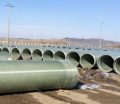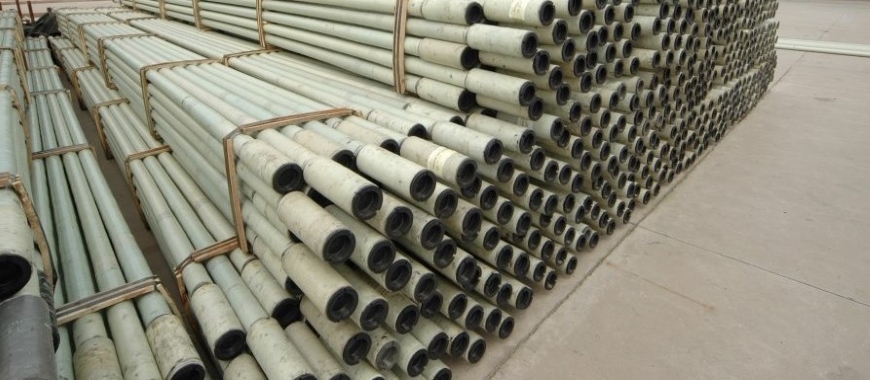
China FRP sand pipe: high-quality, durable, cost-effective FRP mortar pipes with quartz sand for superior strength & corrosion resistance. Resin binds the composite materials together and offers excellent corrosion resistance. Quartz sand enhances structural integrity, making the pipe robust and long-lasting. Manufacturers use a precise winding technique to layer and bond these materials under controlled conditions. This process results in a lightweight, easy-to-handle China FRP sand pipe. The pipe withstands harsh environmental conditions, ensuring long-term reliability. GangLong Fiberglass, a China FRP sand pipe manufacturer, offers corrosion-resistant, lightweight, and abrasion-resistant pipes for sewage, liquids, and infrastructure.
Simplifying Your Life: Key Functionalities
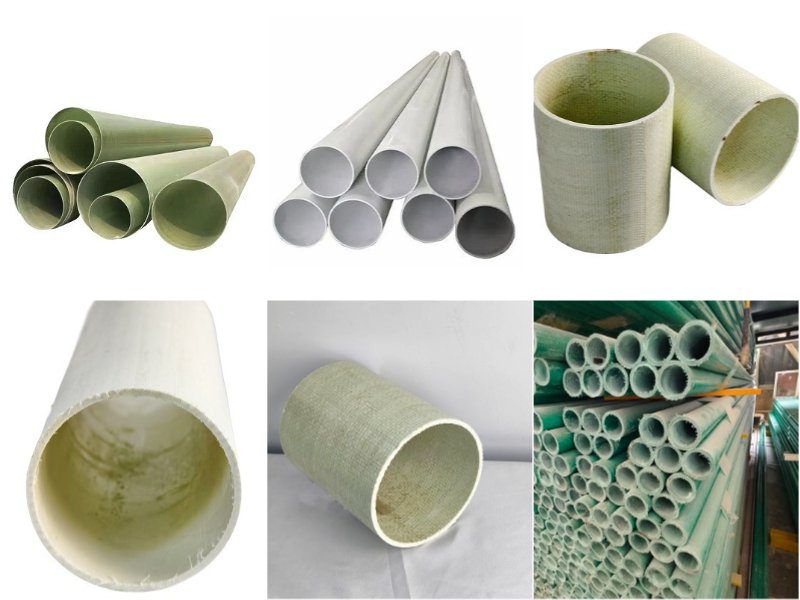
| Attributes | Details |
|---|---|
| Place of Origin | Hebei, China |
| Brand Name | GangLong Fiberglass |
| Product Name | China FRP Sand Pipe |
| Material | Fiberglass Reinforced Plastic |
| Technology | FRP Continuous Production |
| Surface Treatment | Smooth, Plastic Coating, Painting, Sandblasting |
| Processing Services | Uncoiling, Forming, Welding, Punching, Cutting |
| Color | Customized Color |
| Shape | Customized Shape |
| Size | Customized Size |
| Thickness | Customized Thickness |
| Length | Customized Length |
| Quality | High Quality |
| Features | Durable, High Strength, Light Weight |
| Advantages | Flexible and Corrosion-resistant |
| Density | 1.85 g/cm3 |
| Flexural Strength | >=14.2 mV/m |
| Dielectric Constant | <=5.5 |
| Water Absorption (1.6mm Thickness) | <=19 mg |
| Certificate | ISO9001 |
| Application | Construction, Others |
| Sales Unit | Single Item |
| Supply Capacity | 20,000 m/month |
| Packing Details | Bubble Film Packing or as per Customer Requirements |
China FRP Sand Pipe: Manufacturing Process and Composition
Manufacturing Process: Precision and Quality
Step 1: Winding Technique
The manufacturing process begins by winding glass fibers around a mandrel. This technique ensures even distribution of fibers, providing consistent strength and flexibility. It ensures the pipe maintains uniform performance and durability under mechanical stress. The fibers wrap evenly, contributing to the overall structural integrity and reliability of the finished pipe.
Step 2: Impregnation with Resin
After the fibers are wound, resin is applied to impregnate them. The resin bonds the fibers, creating a strong composite material. It enhances the pipe’s corrosion resistance, making it durable in harsh environments. This step plays a crucial role in ensuring that the pipe maintains its integrity and strength over its service life.
Step 3: Layering Quartz Sand
Quartz sand is carefully layered between the glass fibers. This sand increases the rigidity and strength of the pipe, allowing it to withstand higher pressure and mechanical impacts. It also improves the pipe’s thermal stability, ensuring that the pipe performs reliably across a range of temperatures in various industrial applications.
Step 4: Curing Under Controlled Conditions
The pipe undergoes a curing process under controlled heat and pressure. This step solidifies the composite material, locking in its mechanical properties and ensuring resistance to corrosion. The curing process makes the pipe durable and capable of withstanding the harsh conditions it may encounter during its operational life.
Step 5: Final Quality Control
Once the pipe is completed, it undergoes rigorous quality control testing. These tests check for consistency, strength, and durability, ensuring the pipe meets industry standards. This final step guarantees that the pipe will perform reliably and efficiently in industrial environments, offering long-term performance and minimal maintenance needs.
Composition: Glass Fiber, Resin, and Quartz Sand
The performance of China FRP sand pipes is closely linked to their composition. Glass fiber, resin, and quartz sand work together to provide strength, durability, and suitability for industrial applications. Each component plays an essential role, ensuring the pipes perform effectively in demanding conditions.
Glass Fiber: The Reinforcement Backbone
Glass fiber is the main reinforcement material in China FRP sand pipes. Its high tensile strength and flexibility allow the pipes to resist internal and external pressures. The FRP pipe tensile strength ensures the pipe endures mechanical stresses and harsh conditions. The fiber provides structural integrity and resists chemicals, making it ideal for industrial use in aggressive environments.
Resin: The Binding Agent
Resin acts as the binding agent, holding the glass fibers together and giving the pipe its shape. It provides excellent corrosion resistance, ensuring the pipe remains intact when exposed to chemicals, moisture, and other corrosive elements. Resin enhances the pipe’s durability, reducing the need for frequent repairs or replacements, even in extreme conditions.
Quartz Sand: The Structural Enhancer
Quartz sand enhances the structural properties of China FRP sand pipes. It increases the pipe’s rigidity and strength, enabling it to withstand higher pressure and mechanical impacts. Sand also contributes to the pipe’s weight, which adds stability. Additionally, it improves thermal stability, ensuring reliable performance across a wide range of temperatures.
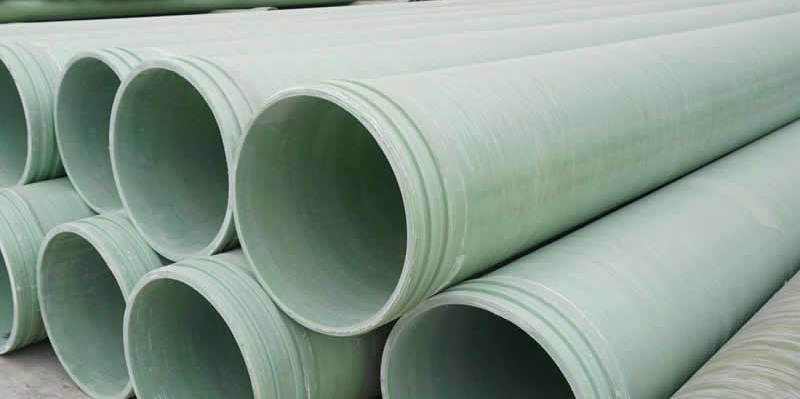
Exploring the Temp Rating for Fiberglass Sheets and Insulation
Advantages and Characteristics of China FRP Sand Pipe in Industrial Applications
China FRP sand pipes are increasingly adopted across various industrial applications due to their superior performance, durability, and cost-effectiveness. These pipes combine the strength of fiberglass with the protective qualities of resin and quartz sand, offering a range of benefits tailored to industries such as oil and gas, chemical processing, water treatment, and power generation. Below are the key advantages and characteristics that make China FRP sand pipes a preferred choice for industrial applications.
Corrosion Resistance
One of the standout features of China FRP sand pipes is their exceptional corrosion resistance. The high-quality resin used in their composition makes these pipes resistant to a wide array of corrosive substances commonly encountered in industries like chemical processing and water treatment. Whether exposed to acids, alkalis, or other reactive chemicals, China FRP sand pipes remain intact and operational for long periods. This resistance significantly reduces the risk of pipe deterioration, minimizing maintenance costs and ensuring a longer service life compared to traditional metal pipes, which are prone to rust and corrosion.
Lightweight and Easy to Handle
Despite their impressive mechanical strength, China FRP sand pipes are much lighter than traditional metal pipes. This lightweight nature makes transportation, handling, and installation easier, particularly in challenging or remote locations. The reduced weight of these pipes means that less heavy machinery is required for installation, leading to a reduction in overall project costs and installation times. Additionally, the ease of handling and maneuvering China FRP pipes allows for more efficient and safer installations, which is crucial for time-sensitive projects.
High Mechanical Strength
China FRP sand pipes endure high mechanical stresses and offer excellent resistance to external pressures, water pressures, and impacts. These pipes maintain high mechanical strength, allowing them to withstand demanding environments typically found in industrial settings. Industries use them in heavy-duty applications, such as transporting crude oil or natural gas, as well as in more delicate environments like chemical processing plants. Manufacturers can customize China FRP sand pipes to meet specific pressure requirements, making them adaptable to a wide range of applications.
Temperature Adaptability
China FRP sand pipes demonstrate remarkable temperature adaptability, withstanding temperatures ranging from below -70°C to above 250°C. This wide temperature tolerance ensures that these pipes remain functional even in extreme weather conditions or industrial environments where temperature fluctuations are common. Additionally, China FRP pipes maintain their structural integrity under freezing conditions, unlike some materials that may crack or become brittle when exposed to low temperatures.
Smooth Inner Surface and Low Fluid Resistance
Another key characteristic of China FRP sand pipes is their smooth inner surface, which reduces fluid resistance. The low roughness coefficient of 0.0084 ensures that fluids flow efficiently through the pipe with minimal friction. As a result, China FRP sand pipes allow for a reduction in pipe diameter while maintaining the same flow rate, contributing to cost savings in material usage and installation. The smooth interior also prevents the buildup of deposits, ensuring the system remains clog-free and maintains optimal performance over time.
Longevity and Low Maintenance
The long-lasting nature of China FRP sand pipes is one of their most significant advantages. With a service life of over 50 years, these pipes require minimal maintenance. Unlike metal pipes, which can suffer from corrosion, rust, and wear over time, China FRP sand pipes are resistant to these issues, reducing the need for frequent repairs or replacements. This long lifespan, combined with their lightweight nature, makes China FRP sand pipes a cost-effective solution for many industries.
Environmental and Health Safety
China FRP sand pipes are non-toxic and do not leach harmful substances into the transported fluids. This makes them ideal for applications involving drinking water, where maintaining water quality is critical. The pipes are also resistant to biological attacks, ensuring that water and other fluids remain uncontaminated throughout the transportation process. In industries like water treatment, the ability of China FRP sand pipes to preserve water quality is particularly valuable.
Ease of Installation
The lightweight and flexible nature of China FRP sand pipes also makes them easier to install. They can be maneuvered and positioned in tight spaces or challenging environments, which simplifies the installation process. Additionally, China FRP sand pipes come with a wide range of fittings and accessories, ensuring a seamless and efficient installation process. Their flexibility also allows them to navigate around obstacles and adapt to various installation conditions, making them an ideal choice for complex projects.
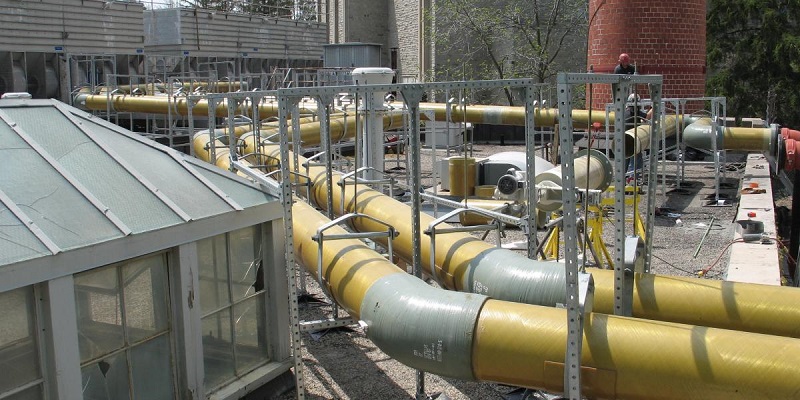
Key Advantages of Using China FRP Irrigation Pipe in Farming
Environmental Impact and Future Prospects of China FRP Sand Pipes
Environmental Impact and Sustainability
Long Lifespan and Durability
China FRP sand pipes are highly durable and require fewer resources for maintenance, repairs, and replacements. Their extended lifespan reduces the environmental impact associated with the production and transportation of new pipes. This longevity helps conserve natural resources, minimize waste, and reduce the frequency of pipeline replacements. UV resistant FRP pipe, like their sand-reinforced counterparts, also offer extended durability and are ideal for outdoor applications where exposure to sunlight can degrade traditional materials. Ultimately, these pipes lower the overall environmental footprint of infrastructure projects.
Recyclability and Material Efficiency
China FRP sand pipes are recyclable at the end of their service life, contributing to environmental sustainability. Although recycling FRP materials is more complex than traditional metals, technological advancements are improving the process. Additionally, the manufacturing of these pipes is more material-efficient compared to conventional materials like steel or concrete, reducing waste and the consumption of natural resources in the production phase.
Lower Environmental Footprint
The production of China FRP sand pipes requires less energy compared to steel or concrete. The lightweight nature of these pipes further reduces transportation costs and emissions. As a result, they contribute to a lower carbon footprint, making them a more sustainable option for infrastructure projects. Their production process generates fewer greenhouse gases and pollutants, aligning with the growing demand for environmentally friendly construction materials.
Promoting Sustainable Construction Practices in China
China has actively embraced sustainable construction practices in line with its commitment to environmental protection. The use of China FRP sand pipes supports this goal by providing an eco-friendly solution for infrastructure projects. Government policies, such as the Green Building Evaluation Standard (GBES), encourage the use of sustainable materials like FRP pipes. These pipes meet the criteria for green building certifications, helping to drive the transition to more sustainable infrastructure development.
Challenges and Future Prospects
Recycling Challenges
Recycling FRP materials presents a challenge, primarily due to their complex composite structure. Unlike traditional materials like steel and concrete, FRP pipe require specialized methods to separate and process the fiberglass and resin components. Although the recycling process is still evolving, ongoing research and technological advancements are making it more feasible. As recycling methods improve, FRP sand pipes will become even more environmentally sustainable, contributing to a circular economy in the construction and infrastructure sectors.
Cost Considerations
The initial cost of China FRP sand pipes is higher than traditional materials such as steel and concrete. However, their long-term benefits, including low maintenance costs, long service life, and resistance to corrosion, make them a more cost-effective option over time. As production technologies improve and market demand increases, the cost of FRP sand pipes is expected to decrease. This will make them more accessible to a wider range of industries, encouraging further adoption of sustainable piping solutions.
Limited Awareness and Adoption
Despite the advantages of China FRP sand pipes, awareness and adoption in certain industries are still limited. Many companies are reluctant to switch from traditional materials due to the higher upfront costs and lack of familiarity with FRP technology. As more case studies and successful projects demonstrate the long-term savings and benefits of FRP sand pipes, the industry is likely to see greater adoption. Increased education and marketing efforts will help overcome this barrier, promoting FRP pipes as a more sustainable and efficient solution for modern infrastructure.
Production Scalability
Another challenge is the scalability of China FRP sand pipe production. Although FRP pipes are increasingly being used, scaling up production to meet the growing demand while maintaining quality can be challenging. Manufacturers will need to invest in advanced production techniques and automation to increase output without compromising the strength and durability of the pipes. Overcoming this challenge will help ensure that FRP sand pipes become a mainstream material for large-scale infrastructure projects worldwide.
China FRP Sand Pipe Compare to GRP Sand Pipe
China FRP sand pipes and GRP sand pipes are both composite piping solutions, offering strength, durability, and corrosion resistance. While they share similarities, they also have some key differences in terms of materials, performance, and applications.
| Factors | China FRP Sand Pipe | GRP Sand Pipe |
|---|---|---|
| Composition | Fiberglass, resin, and quartz sand. | Fiberglass and resin with added sand for strength. |
| Strength and Durability | High durability, corrosion resistance. | Strong and corrosion-resistant, suited for high pressure. |
| Temperature Resistance | Superior temperature resistance. | Good chemical resistance, lower temperature tolerance. |
| Applications | Sand transport, mining, oil, and gas. | Water distribution, sewage, and fluid handling. |
| Cost and Maintenance | Higher initial cost, low maintenance. | Higher cost, durable and low maintenance. |
China FRP Sand Pipe: Customization and Specifications
China FRP sand pipes offer extensive customization, making them suitable for various industrial and construction applications. These pipes can be tailored to meet specific project needs, ensuring they perform effectively in different environments. Customizing dimensions, thickness, pressure ratings, and materials allows for the creation of pipes that deliver optimal performance for each unique application.
Customization in Dimensions
The diameter and length of China FRP sand pipes can be adjusted based on project requirements. Larger diameters are suitable for transporting high volumes of fluids, while smaller diameters are ideal for tight spaces or precise flow control. Customizing the length reduces the number of joints, enhancing system integrity and reducing installation costs.
Thickness and Structural Integrity
Customizing the wall thickness of China FRP sand pipes ensures the required structural integrity for high-pressure or external load applications. Thicker pipes provide greater strength to withstand pressures or physical forces like soil pressure or vehicular traffic. Adjusting thickness also optimizes weight and material usage, reducing transport and material costs without compromising performance.
Pressure Ratings and Performance
China FRP sand pipes can be tailored with different pressure ratings to meet specific industrial needs. Higher pressure ratings are required in applications like chemical processing or water distribution, where fluids are transported under significant pressure. Custom pressure ratings ensure reliable performance and safety, even in environments with pressure fluctuations or surges.
Tailoring to Specific Project Requirements
The customization options for China FRP sand pipes let you tailor them to meet unique project requirements, including those using China FRP spraying pipe. These pipes adapt to corrosive environments, high temperatures, and fluid transport needs, providing flexibility and reliability for various industrial uses.
Materials and Specifications
China FRP sand pipes are made from high-quality materials such as resin, surface mat, chopped fiber, continuous glass fiber, and quartz sand. These materials contribute to the pipes’ strength, durability, and chemical resistance.
- Diameter Range: The pipes typically range from 300mm to 4000mm in diameter, depending on the project specifications.
- Length: Standard lengths include 6m, 10m, and 12m, with the option for custom lengths.
- Wall Thickness: Wall thickness ranges from 5mm to 50mm, depending on the diameter and application.
- Pressure Class: These pipes can be tailored for pressure ratings from 0.1 MPa to 2.5 MPa.
- Colors: China FRP sand pipes are typically produced in green, blue, or gray, with custom colors available for aesthetic or application needs.
- Surface Treatment: The pipes come with various surface treatments, including smooth, sand, or custom textures.
Packaging and Accessories
China FRP sand pipes are typically packaged in bundles or stacks, with protective wrapping or end caps for safe transport. Accessories like elbows, tees, Y-joints, T-joints, and reducers are available to complement the pipes, ensuring seamless installation and integration with existing systems. These fittings are customized to suit the specific requirements of each project.
Standards
China FRP sand pipes adhere to standards such as JC/T838-1998, “Glass Fiber Reinforced Thermosetting Resin Sand Pressure Pipe.” They also follow the National Ministry of Construction Standards, ensuring high-quality and reliable pipes for various industrial applications. These standards ensure that the pipes meet rigorous performance and safety requirements.
Difference Between GRP pipe and FRP pipe
Applications of China FRP Sand Pipe
China FRP sand pipes have become a vital component in various industrial and infrastructure projects across China. Their exceptional durability, corrosion resistance, and adaptability make them ideal for many applications. These pipes contribute significantly to the efficiency and longevity of infrastructure systems, reducing maintenance costs and increasing operational reliability. This article explores the composition, manufacturing process, and diverse applications of China FRP sand pipes in major infrastructure projects across the country.
FRP Sand Pipe Applications in China’s Infrastructure Projects
China FRP sand pipes have proven to be an integral part of various infrastructure projects in China. These pipes play a crucial role in enhancing the efficiency and longevity of water supply, sewage systems, oil and gas transportation, chemical processing, and more. Their wide applications demonstrate their versatility, strength, and reliability in multiple industrial and public utilities projects.
Water Supply and Distribution Systems
In water supply and distribution systems, China FRP sand pipes are crucial. Their corrosion resistance ensures reliable delivery of potable water, even under high pressures. These pipes handle long-distance water transportation effectively. The non-toxic composition ensures that water remains uncontaminated. FRP sand pipes provide an efficient, safe solution for public water systems, supporting urban and rural areas.
Sewage and Wastewater Treatment Systems
China FRP sand pipes are essential in sewage and wastewater treatment systems. These pipes resist corrosion and biological attacks, making them ideal for handling aggressive wastewater chemicals. The pipes maintain their structural integrity and durability in harsh environments, reducing maintenance needs and improving the longevity of sewage networks and treatment plants. They ensure efficient wastewater management while keeping operational costs low.
Oil and Gas Transportation
In the oil and gas sector, China FRP sand pipes are used to transport crude oil, natural gas, and petroleum products over long distances. Their high-pressure resistance and corrosion-resistant properties make them ideal for these applications. These pipes withstand harsh environmental conditions, such as chemicals and extreme temperatures. The lightweight nature also simplifies installation, especially in remote or hard-to-reach areas, enhancing overall efficiency.
Chemical Processing Plants
China FRP sand pipes play a key role in chemical processing plants. They are used to transport corrosive chemicals and liquids, maintaining the purity of materials being transported. The pipes resist chemical corrosion, unlike traditional metal pipes that degrade quickly. China FRP sand pipes provide a long-lasting, low-maintenance solution for chemical industries, supporting operational efficiency and reducing system downtime.
Slurry Transportation in Power Plants
China FRP sand pipes are highly effective in slurry transportation systems, particularly in power plants. These systems transport abrasive materials like coal ash, which can cause significant wear and tear on pipes. FRP sand pipes’ durability, resistance to abrasion and corrosion, make them an ideal choice for these high-wear applications. They help reduce maintenance downtime and operational costs in power plants by offering a more durable, efficient piping solution.
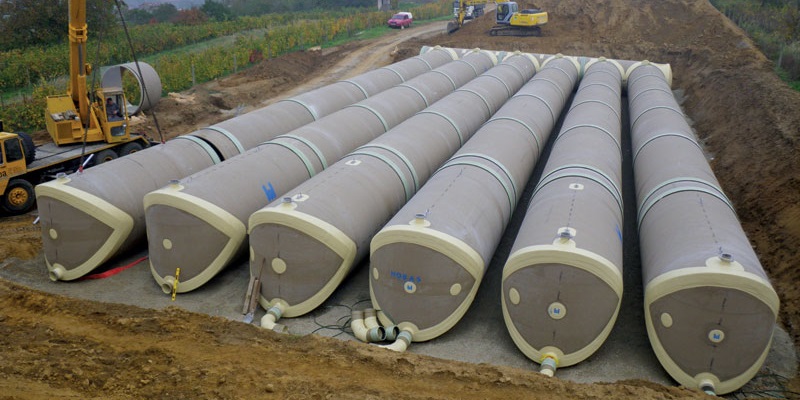
Alias and Similar Names of China FRP Sand Pipe
China FRP Pipe with Sand Reinforced
China FRP Pipe with Sand Reinforced integrates sand into its structure, improving strength and stability. This addition enhances the pipe’s resistance to external pressure, making it suitable for industrial applications. In industries with heavy loads or mechanical stress, this pipe variant offers superior performance. It is particularly useful in sectors like chemical processing and mining. The added sand ensures better durability, making it a strong alternative to China FRP sand pipes in demanding operational environments.
China FRP Sanded Pipe
China FRP Sanded Pipe incorporates a sand layer on the inside or outside of the pipe. This sanded layer enhances the pipe’s abrasion resistance, making it suitable for environments with high friction. It is particularly effective in industries where materials like slurries or aggregates are transported. The sanded design provides protection against wear and tear, extending the lifespan of the pipe. In many cases, this pipe serves as a robust alternative to China FRP sand pipes, especially where abrasion resistance is essential.
China Fiberglass Reinforced Plastic Sanded Pipe
China Fiberglass Reinforced Plastic Sanded Pipe combines fiberglass and sand for improved durability. The addition of sand strengthens the pipe’s resistance to pressure and external stress. This makes the pipe ideal for heavy-duty applications, offering high strength and resistance to harsh conditions. It performs well in industries like construction, mining, and oil and gas, where durability is key. This variant shares many benefits with China FRP sand pipes, offering long-lasting performance in tough environments.
China FRP Filament Wound Pipe with Sanded Reinforced
China FRP Filament Wound Pipe with Sanded Reinforced uses a filament winding process to create a strong and durable structure. The sand reinforcement adds further durability, making it resistant to both internal and external pressures. This pipe is suitable for high-stress applications like water treatment and chemical processing. Its combination of filament winding and sand reinforcement makes it highly durable, similar to China FRP sand pipes. It is ideal for industries requiring a robust and reliable piping solution in demanding environments.
FAQs about China FRP Sand Pipe
FRP stands for Fiberglass Reinforced Plastic, a composite material widely used in piping systems. It offers exceptional strength, corrosion resistance, and lightweight properties. FRP is made by reinforcing plastic with fiberglass, giving the pipe durability and resilience against harsh conditions. This makes FRP ideal for industries handling corrosive chemicals, high-temperature fluids, and demanding applications.
The main advantage of FRP is its corrosion resistance, unlike metal piping that rusts or corrodes. FRP pipes do not rust, even when exposed to aggressive chemicals or saltwater. This extends the lifespan and reduces maintenance costs. Additionally, FRP pipes are lightweight, making them easier and more cost-effective to transport and install. The flexibility of FRP allows for molding into various shapes and sizes, offering high customization for project needs.
FRP (Fiberglass Reinforced Plastic) and PVC (Polyvinyl Chloride) are commonly used in piping systems, though they differ significantly. FRP combines fiberglass and plastic to form a composite material, while PVC is a synthetic plastic polymer.
With high strength, durability, and corrosion resistance, these pipes are perfect for industrial applications. In contrast, PVC pipes excel in residential plumbing, drainage, and commercial systems due to their lightweight, ease of installation, and chemical corrosion resistance. They withstand harsh chemicals, high temperatures, and mechanical stress. PVC pipes serve in residential plumbing, drainage systems, and commercial plumbing. They are lightweight, easy to install, and resist chemical corrosion, but they lack the mechanical strength of FRP pipes.
FRP pipes handle higher temperatures than PVC pipes, which soften under heat. FRP works better for hot fluids or steam applications. Customizing the shape and size of these pipes offers flexibility for specific projects, while PVC pipes come in standard sizes.
FRP (Fiberglass Reinforced Plastic) and GRP (Glass Reinforced Plastic) pipes are often used interchangeably, but they have subtle differences. Both materials reinforce plastic with fiberglass, providing high strength, corrosion resistance, and durability. However, FRP and GRP can refer to slightly different materials or manufacturing processes depending on the industry or region.
In many cases, people consider FRP and GRP the same. The terms describe pipes made from fiberglass-reinforced composites. In some cases, FRP refers to any fiber-reinforced plastic, while GRP specifically refers to pipes reinforced with glass fibers. This distinction becomes important when using different fibers, such as carbon or aramid, to achieve specific properties.
The choice between FRP or GRP pipes depends on regional preferences or industry standards. People commonly use GRP in Europe, while FRP is more widely used in the United States. Both types perform excellently in terms of corrosion resistance, strength, and longevity, making them suitable for various industrial applications. The choice often depends on local terminology and project needs, with both delivering comparable results.
The life expectancy of FRP (Fiberglass Reinforced Plastic) pipes is one of their most attractive features. These pipes can last from 30 to 50 years, depending on the application, environmental conditions, and maintenance practices. This longevity is due to their excellent resistance to corrosion, chemicals, and mechanical wear.
FRP pipes can withstand harsh conditions that cause metal pipes to deteriorate quickly. In corrosive chemicals, saltwater, or high temperatures, FRP pipes maintain their structural integrity much longer. This resistance reduces the need for frequent maintenance and replacement, lowering overall costs.
The actual lifespan of FRP pipes can vary based on material quality, manufacturing process, and operating conditions. Proper installation and regular maintenance are crucial for achieving full life expectancy. Well-maintained FRP pipes can last longer than 50 years, making them a reliable choice for long-term industrial applications.
FRP stands for Fiberglass Reinforced Plastic, a composite material that combines thermoset resin and glass fibers. In the context of FRP sand pipes, the term refers to pipes made from this material, designed to offer high strength, corrosion resistance, and light weight. Industries use these pipes in various applications, including transporting sand and other abrasive materials. The fiberglass fibers reinforce the plastic, increasing tensile strength and durability, which makes it ideal for handling challenging environments like sand slurry transport or mining processes. Many industries, including construction, chemicals, and water treatment, favor FRP pipes for their ability to withstand harsh conditions and extreme temperatures. The combination of lightweight construction and high performance makes FRP pipes a superior choice for many applications compared to traditional materials like metal or PVC.
FRP pipe material is a composite consisting of fiberglass (glass fibers) and a plastic resin, typically a thermoset resin such as epoxy or polyester. The fiberglass reinforcement gives the material its strength and rigidity, while the resin binds the fibers together and provides corrosion resistance. This combination creates a highly durable, lightweight, and flexible pipe that can withstand environmental factors like extreme temperatures, chemicals, and physical wear. In the case of China FRP sand pipes, these pipes are specifically designed to handle the abrasion and pressure caused by transporting materials like sand and slurry. The ability of FRP pipes to resist corrosion from sand and other chemicals makes them a reliable choice for long-term use in industries such as mining, construction, and water treatment. Moreover, the manufacturing process allows for various sizes and customizations to suit different requirements.
FRP (Fiberglass Reinforced Plastic) and GRE (Glass Reinforced Epoxy) pipes are both composite materials but differ in resin content and applications. FRP pipes use various resins like polyester, vinyl ester, or epoxy, combined with fiberglass for strength and durability. These pipes are versatile and used in water treatment, sand transport, and industrial piping systems.
GRE pipes are a subset of FRP pipes that use epoxy resin as the matrix. Epoxy offers superior chemical resistance, making GRE pipes ideal for transporting highly corrosive materials. Industries like oil, gas, marine, and wastewater treatment use GRE pipes because they suit harsh chemical environments. Both materials offer similar benefits, but GRE pipes are stronger and more chemical-resistant than standard FRP pipes.
FRP pipe joints come in various configurations depending on the application and system flexibility or rigidity. The most common types of FRP pipe joints are:
Flanged Joints: Two pipes with flanges bolt together, creating a secure connection. This type works for larger-diameter pipes and commonly fits China FRP sand pipes, ensuring a tight seal and easy maintenance.
Butt-and-Sleeve Joints: The ends of two pipes align and bond with a resin-filled sleeve. This joint type works well for smaller installations with limited space.
Push-on Joints: A gasket system allows pipes to slide and lock into place. Push-on joints offer easy installation and are used in systems requiring quick connection or disconnection.
Threaded Joints: The pipe ends are threaded to screw together. This joint type is common for smaller pipes and applications where disassembly is sometimes necessary.
Each joint type offers unique benefits regarding installation ease, strength, and flexibility.
FRP stands for Fiberglass Reinforced Plastic, a composite material that combines glass fibers and resin. The fiberglass provides strength and durability, while the resin offers corrosion resistance and the flexibility needed to create various pipe sizes and shapes. China uses FRP to construct highly durable sand pipes that withstand the harsh conditions of transporting abrasive materials like sand. The material’s key advantages include its high strength-to-weight ratio, which makes it both strong and lightweight, as well as its excellent resistance to corrosion, chemical attack, and high temperatures. FRP pipes are increasingly popular in industrial and environmental applications where traditional piping materials like steel or PVC might degrade over time due to abrasion or harsh chemicals, making FRP a preferred material in many industries.
Yes, FRP (Fiberglass Reinforced Plastic) is inherently waterproof due to its resin base, typically an epoxy or polyester resin, which is highly resistant to water absorption. This makes FRP pipes and other products made from the material ideal for use in wet environments, including those that require handling of water, sewage, or sand slurry. China FRP sand pipes, for example, are designed to transport abrasive materials, such as sand, which are often carried in water. The waterproof properties of FRP prevent corrosion from prolonged exposure to moisture and maintain the pipe’s structural integrity even when submerged or exposed to humid conditions. Additionally, the smooth surface of FRP pipes reduces the risk of clogging or degradation over time, ensuring long-lasting performance in water-based or wet conditions.
While FRP (Fiberglass Reinforced Plastic) is not typically as strong as steel in terms of pure tensile strength, it has several advantages over steel in specific applications. FRP offers a high strength-to-weight ratio, making it much lighter than steel while still providing comparable strength for many applications. This makes FRP pipes ideal for use in industries like sand transport, where weight is a critical factor. Additionally, FRP is more resistant to corrosion, making it superior to steel in environments where chemical exposure or abrasive materials (like sand) are common. China FRP sand pipes, for example, benefit from these characteristics, as they are lightweight, corrosion-resistant, and capable of withstanding the harsh conditions of abrasive material transport. While applications requiring high load-bearing capacity might prefer steel, FRP often proves more practical due to its corrosion resistance and lighter weight.
The three main types of plastic pipe are:
PVC (Polyvinyl Chloride): PVC is durable, lightweight, and corrosion-resistant. It commonly serves in water supply, irrigation, and drainage. China FRP sand pipes often work alongside PVC pipes in industrial settings, where both lightweight and durable materials are needed.
CPVC (Chlorinated Polyvinyl Chloride): CPVC is similar to PVC but can withstand higher temperatures. It is ideal for hot water systems and various industrial applications due to its corrosion resistance.
PEX (Cross-Linked Polyethylene): PEX is flexible and mainly used for water distribution in residential and commercial plumbing. It resists freezing and corrosion, making it popular for plumbing systems.
Each type of plastic pipe offers advantages based on temperature resistance, flexibility, and ease of installation. FRP pipes are also plastic pipes, reinforced with fiberglass for extra strength and durability.

As the editor of GangLong Fiberglass, I have years of experience and in-depth research, focusing on cable tray products, fiberglass solutions, and grille systems. I incorporate years of industry insights and practical experience into every content, committed to promoting the progress of the industry. At GangLong Fiberglass, my commitment is reflected in every product, from innovative cable trays to durable fiberglass solutions and sturdy grille systems. As an authoritative voice in the industry, my goal is to provide valuable information to professionals and businesses and promote forward-looking solutions.


